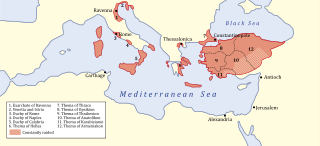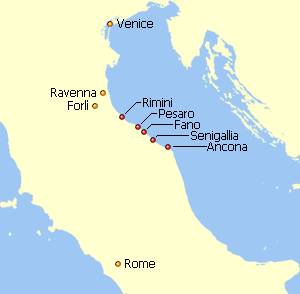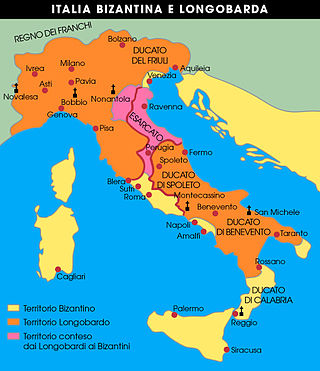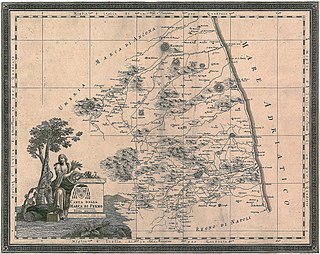Related Research Articles
Pope Gregory II was the bishop of Rome from 19 May 715 to his death. His defiance of Emperor Leo III the Isaurian as a result of the iconoclastic controversy in the Eastern Empire prepared the way for a long series of revolts, schisms, and civil wars that eventually led to the establishment of the temporal power of the popes.

Pope Gregory III was the bishop of Rome from 11 February 731 to his death. His pontificate, like that of his predecessor, was disturbed by Byzantine iconoclasm and the advance of the Lombards, in which he invoked the intervention of Charles Martel, although ultimately in vain. He was the last pope to seek the consent of the Byzantine exarch of Ravenna for his election, the last pope of Syrian origin, and the last non-European pope until the election of Pope Francis more than 1,271 years later in 2013.

Pope Zachary was the bishop of Rome from 28 November 741 to his death. He was the last pope of the Byzantine Papacy. Zachary built the original church of Santa Maria sopra Minerva, forbade the traffic of slaves in Rome, negotiated peace with the Lombards, and sanctioned Pepin the Short's usurpation of the Frankish throne from Childeric III. Zachary is regarded as a capable administrator and a skillful and subtle diplomat in a dangerous time.
The 740s decade ran from January 1, 740, to December 31, 749.
Eutychius was the last Exarch of Ravenna, heading the Exarchate from 726 or 727 until 751.

The Duchy of Spoleto was a Lombard territory founded about 570 in central Italy by the Lombard dux Faroald. Its capital was the city of Spoleto.

Liutprand was the king of the Lombards from 712 to 744 and is chiefly remembered for his multiple phases of law-giving, in fifteen separate sessions from 713 to 735 inclusive, and his long reign, which brought him into a series of conflicts, mostly successful, with most of Italy. He is often regarded as the most successful Lombard monarch, notable for the Donation of Sutri in 728, which was the first accolade of sovereign territory to the Papacy.

The Donation of Sutri was an agreement reached at Sutri by Liutprand, King of the Lombards and Pope Gregory II in 728. At Sutri, the two reached an agreement by which the city and some hill towns in Latium were given to the Papacy, "as a gift to the blessed Apostles Peter and Paul" according to the Liber Pontificalis. The pact formed the first extension of papal territory beyond the confines of the Duchy of Rome and was the first of two land transfers from Liutprand to the Church of Rome.

Godescalc was the Duke of Benevento in Langobardia minor from 740 until his assassination in 743. Godescalc's accession was without approval of the King.
Ariulf was the second Duke of Spoleto from 592 until his own death.
Transamund II was the Lombard Duke of Spoleto from 724 to 745, though he was twice driven from power by the king, Liutprand. Transamund rose to power by deposing his own father, Faroald II, and tonsuring him in a monastery.
Hilderic was the Lombard Duke of Spoleto briefly from 739 to 740. He was the first appointee of Liutprand, King of the Lombards, against the rebellious Thrasimund II.

The Duchy of Rome was a state within the Byzantine Exarchate of Ravenna. Like other Byzantine states in Italy, it was ruled by an imperial functionary with the title of dux. The duchy often came into conflict with the Papacy over supremacy within Rome. After the founding of the Papal States in 756, the Duchy of Rome ceased to be an administrative unit and 'dukes of Rome', appointed by the popes rather than emperors, are only rarely attested.
Thrasimund I or Transamund I was the Count of Capua and then Duke of Spoleto, a faithful follower of Grimoald I of Benevento.
Faroald II was the duke of Spoleto from 703, when he succeeded his own father Thrasimund I.

Gregory I was the Count of Tusculum sometime between 954 and 1012. Consul et dux 961, vir illustrissimus 980, praefectus navalis 999. He was the son of Alberic II, and Alda of Vienne. His half-brother was Pope John XII.

In the Byzantine Empire, the Duchy of the Pentapolis was a duchy, a territory ruled by a duke (dux) appointed by and under the Exarch of Ravenna. The Pentapolis consisted of the cities of Ancona, Fano, Pesaro, Rimini and Sinigaglia. It lay along the Adriatic coast between the rivers Marecchia and Misco immediately south of the core territory of the exarchate ruled directly by the exarch, east of the Duchy of Perugia, another Byzantine territory, and north of the Duchy of Spoleto, which was part of the Lombard Kingdom of Italy. The duchy probably extended inland as far as the Apennine Mountains, perhaps beyond, and its southernmost town was Humana (Numera) on the northern bank of the Misco. The capital of the Pentapolis was Rimini and the duke was both the civil and military authority in the duchy.
Lucerius was the third Abbot of Farfa, succeeding Aunepert in 724 at the latest. He was originally from Provence and had been raised at Farfa by Thomas of Maurienne, the first abbot. Lucerius' abbacy was a period of growth and expansion on the part of the abbey. In his first year, he received a grant of a church with its (unspecified) lands from Duke Thrasimund II of Spoleto. This church, dedicated to Saint Getulius, lay within the jurisdiction of the Diocese of Rieti, and according to the tenth-century Exceptio Relationum Thrasimund had to compensate the bishop for his loss.

The Duchy of Perugia was a duchy in the Italian part of the Byzantine Empire. Its civil and military administration was overseen by a duke (dux) appointed by and under the authority originally of the Praetorian Prefect of Italy (554–584) and later of the Exarch of Ravenna (584–751). Its chief city and namesake was Perugia (Perusia), located at its centre. It was a band of territory connecting the Duchy of the Pentapolis to its northeast with the Duchy of Rome to its southwest, and separating the duchies of Tuscia and Spoleto, both parts of the Lombard Kingdom of Italy. It was of great strategic significance to the Byzantines since it provided communication between Rome, the city of the Popes, and Ravenna, the capital of the Exarchate. Since it cut off the Duke of Spoleto from his nominal overlord, the king ruling from Pavia, it also disturbed the Lombard kingdom, which was a constant thorn in the Byzantines' side. This strategic importance meant that many Lombard and Byzantine armies passed through it.

The March of Fermo was a frontier territory (march) of the Holy Roman Empire in the Kingdom of Italy between the late 10th and early 12th centuries. It faced the Principality of Benevento and later the Duchy of Apulia to the south. It covered part of the modern regions of Marche and Abruzzo.
References
- ↑ Lars Ulwencreutz (November 2013). Ulwencreutz's The Royal Families in Europe V. Lulu.com. p. 350–. ISBN 978-1-304-58135-8.